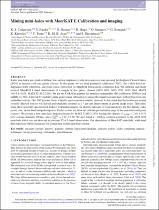| dc.description.abstract | Radio mini-halos are clouds of diffuse, low-surface brightness synchrotron emission that surround the Brightest Cluster Galaxy
(BCG) in massive cool-core galaxy clusters. In this paper, we use third generation calibration (3GC), also called directiondependent (DD) calibration, and point source subtraction on MeerKAT extragalactic continuum data. We calibrate and image
archival MeerKAT L-band observations of a sample of five galaxy clusters (ACO 1413, ACO 1795, ACO 3444, MACS
J1115.8+0129, MACS J2140.2-2339). We use the CARACal pipeline for direction-independent (DI) calibration, DDFacet and
killMS for 3GC, followed by visibility-plane point source subtraction to image the underlying mini-halo without bias from any
embedded sources. Our 3GC process shows a drastic improvement in artefact removal, to the extent that the local noise around
severely affected sources was halved and ultimately resulted in a 7 per cent improvement in global image noise. Thereafter,
using these spectrally deconvolved Stokes I continuum images, we directly measure for four mini-halos the flux density, radio
power, size, and in-band integrated spectra. Further to that, we show the in-band spectral index maps of the mini-halo (with point
sources). We present a new mini-halo detection hosted by MACS J2140.2-2339, having flux density S1.28 GHz = 2.61 ± 0.31
mJy, average diameter 296 kpc, and α1.5 GHz
1 GHz = 1.21 ± 0.36. We also found a ∼100 kpc southern extension to the ACO 3444
mini-halo which was not detected in previous VLA L-band observations. Our description of MeerKAT wide-field, wide-band
data reduction will be instructive for conducting further mini-halo science. | en_US |

